A Novel High Gain Monopole Antenna Array for 60 GHz Millimeter-Wave Communications
Abstract
:1. Introduction
2. Antenna Design
2.1. The Proposed Single Microstrip Monopole Antenna
2.1.1. The Proposed Patch Antenna Structure
2.1.2. The Proposed Ground Antenna Structure
2.2. The Proposed Microstrip Monopole Antenna Array
3. Results
3.1. The Proposed Single Element Monopole Antenna Results
3.2. The Proposed Microstrip Antenna Array Results
4. Conclusions
Author Contributions
Funding
Conflicts of Interest
References
- Rappaport, T.S.; Murdock, J.N.; Gutierrez, F. State of the art in 60-GHz integrated circuits and systems for wireless communications. IEEE 2011, 99, 1390–1436. [Google Scholar] [CrossRef]
- Daniels, R.C.; Murdock, J.N.; Rappaport, T.S.; Heath, R.W. 60 GHz wireless: Up close and personal. IEEE Microw. Mag. 2010, 11, 44–50. [Google Scholar] [CrossRef]
- Yassin, M.E.; Mohamed, H.A.; Abdallah, E.A.F.; El-Hennawy, H.S. Single Fed 4G/5G Multiband 2.4/5.5/28 GHz Antenna. IET Microw. Antennas Propag. 2019, 13, 286–290. [Google Scholar] [CrossRef]
- Zhang, J.; Ge, X.; Li, Q.; Guizani, M.; Zhang, Y. 5G millimeter-wave antenna array: Design and challenges. IEEE Wirel. Commun. 2016, 24, 106–112. [Google Scholar] [CrossRef]
- Haraz, O.; Ali, M.M.M.; Elboushi, A.; Sebak, A.R. Four-element dual-band printed slot antenna array for the future 5G mobile communication networks. In Proceedings of the 2015 IEEE International Symposium on Antennas and Propagation & USNC/URSI National Radio Science Meeting, Vancouver, BC, Canada, 19–25 July 2015; pp. 1–2. [Google Scholar]
- Chen, F.C.; Hu, H.T.; Li, R.S.; Chu, Q.X.; Lancaster, M.J. Design of filtering microstrip antenna array with reduced sidelobe level. IEEE Trans. Antennas Propag. 2016, 65, 903–908. [Google Scholar] [CrossRef]
- Hu, H.T.; Chen, F.C.; Qian, J.F.; Chu, Q.X. A differential filtering microstrip antenna array with intrinsic common-mode rejection. IEEE Trans. Antennas Propag. 2017, 65, 7361–7365. [Google Scholar] [CrossRef]
- Yin, J.; Wu, Q.; Yu, C.; Wang, H.; Hong, W. Low-sidelobe-level series-fed microstrip antenna array of unequal interelement spacing. IEEE Antennas Wirel. Propag. Lett. 2017, 16, 1695–1698. [Google Scholar] [CrossRef]
- Saad, A.A.R.; Mohamed, H.A. printed millimeter-wave mimo-based slot antenna arrays for 5G networks. AEU Int. J. Electron. Commun. 2019, 99, 59–69. [Google Scholar] [CrossRef]
- Rajagopalan, H.; Rahmat-Samii, Y. Dielectric and conductor loss quantification for microstrip reflectarray: Simulations and measurements. IEEE Trans. Antennas Propag. 2008, 56, 1192–1196. [Google Scholar] [CrossRef]
- Levine, E.; Malamud, G.; Shtrikman, S.; Treves, D. A study of microstrip array antennas with the feed network. IEEE Trans. Antennas Propag. 1989, 37, 426–434. [Google Scholar] [CrossRef]
- Ali, M.H.; Sherif, N.H.; Abd-almuhsen, G.S. Bandwidth enhancement of a microstrip patch antenna using inverted-f shaped defected ground structure. Am. Sci. Res. J. Eng. Technol. Sci. 2019, 54, 20–29. [Google Scholar]
- Weng, L.H.; Guo, Y.C.; Shi, X.W.; Chen, X.Q. An overview on defected ground structure. Prog. Electromagn. Res. 2008, 7, 173–189. [Google Scholar] [CrossRef] [Green Version]
- Guha, D.; Biswas, M.; Antar, Y.M. Microstrip patch antenna with defected ground structure for cross polarization suppression. IEEE Antennas Wirel. Propag. Lett. 2005, 4, 455–458. [Google Scholar] [CrossRef]
- Wei, K.; Li, J.; Wang, L.; Xing, Z.; Xu, R. S-shaped periodic defected ground structures to reduce microstrip antenna array mutual coupling. Electron. Lett. 2016, 52, 1288–1290. [Google Scholar] [CrossRef]
- Wei, K.; Li, J.Y.; Wang, L.; Xu, R.; Xing, Z.J. A new technique to design circularly polarized microstrip antenna by fractal defected ground structure. IEEE Trans. Antennas Propag. 2017, 65, 3721–3725. [Google Scholar] [CrossRef]
- Eldek, A.A. Numerical analysis of a small ultra wideband microstrip-fed tap monopole antenna. Prog. Electromagn. Res. 2006, 65, 59–69. [Google Scholar] [CrossRef] [Green Version]
- Bisht, S.; Saini, S.; Prakash, V.; Nautiyal, B. Study the various feeding techniques of microstrip antenna using design and simulation using CST microwave studio. Int. J. Emerg. Technol. Adv. Eng. 2014, 4, 318–324. [Google Scholar]
- Sharma, S.; Tripathi, C.C.; Rishi, R. Impedance matching techniques for microstrip patch antenna. Indian J. Sci. Technol. 2017, 10, 1–16. [Google Scholar] [CrossRef]
- Sharaf, M.H.; Zaki, A.I.; Hamad, R.K.; Omar, M.M. A novel dual-band (38/60 GHz) patch antenna for 5G mobile handsets. Sensors 2020, 20, 2541. [Google Scholar] [CrossRef]
- Khalid, H.; Khalid, M.; Fatima, A.; Khalid, N. MIMO antenna with defected ground structure for mm-wave 5G applications. In Proceedings of the 2019 13th International Conference on Mathematics, Actuarial Science, Computer Science and Statistics (MACS), Karachi, Pakistan, 14–15 December 2019; pp. 1–6. [Google Scholar]
- Raviteja, G.V. A 2 × 2 millimeter-wave microstrip antenna array for 5G applications. Eur. J. Eng. Res. Sci. 2019, 4, 55–58. [Google Scholar] [CrossRef]
- Şeker, C.; Güneşer, M.T. A single band antenna design for future millimeter wave wireless communication at 38 GHz. Eur. J. Eng Form. Sci. 2018, 2, 34–38. [Google Scholar]
- Akbari, M.; Koohestani, M.; Ghobadi, C.; Nourinia, J. A new compact planar UWB monopole antenna. Int. J. RF Microw. Comput. Aided Eng. 2011, 21, 216–220. [Google Scholar] [CrossRef]
- Ahmad, F.; Tlili, B. Design and analysis of millimeter wave double F slot patch antenna for future 5G wireless communication. In Proceedings of the 2017 International Conference on Electrical and Computing Technologies and Applications (ICECTA), Ras Al Khaimah, UAE, 21–23 November 2017; pp. 1–4. [Google Scholar]
- Felic, G.; Thomas, C.; Skafidas, E. Design of coplanar waveguide-fed slot/patch antenna with wire bond for a 60-GHz complementary metal-oxide-semiconductor transceiver IET Microw. Antennas Propag. 2011, 5, 490–494. [Google Scholar]
- Haider, M.F.; Alam, S.; Sagor, M.H. V-shaped patch antenna for 60 GHz mm waveave communications. In Proceedings of the 2018 3rd International Conference for Convergence in Technology (I2CT), Pune, India, 6–8 April 2018; pp. 1–4. [Google Scholar]
- Hannachi, C.; Tatu, S.O. A compact V-Band planar Gap-Coupled 4 × 1 antenna array: Improved design and analysis. IEEE Access 2017, 5, 8763–8770. [Google Scholar] [CrossRef]
- Park, Y.; Bang, J.; Choi, J. Dual-circularly polarized 60 GHZ beam-steerable antenna array with 8 × 8 butler matrix. Appl. Sci. 2020, 10, 2413. [Google Scholar] [CrossRef] [Green Version]
- Issa, K.; Fathallah, H.; Ashraf, M.A.; Vettikalladi, H.; Alshebeili, S. Broadband high-gain antenna for millimetre-wave 60-GHz band. Electronics 2019, 8, 1246. [Google Scholar] [CrossRef] [Green Version]



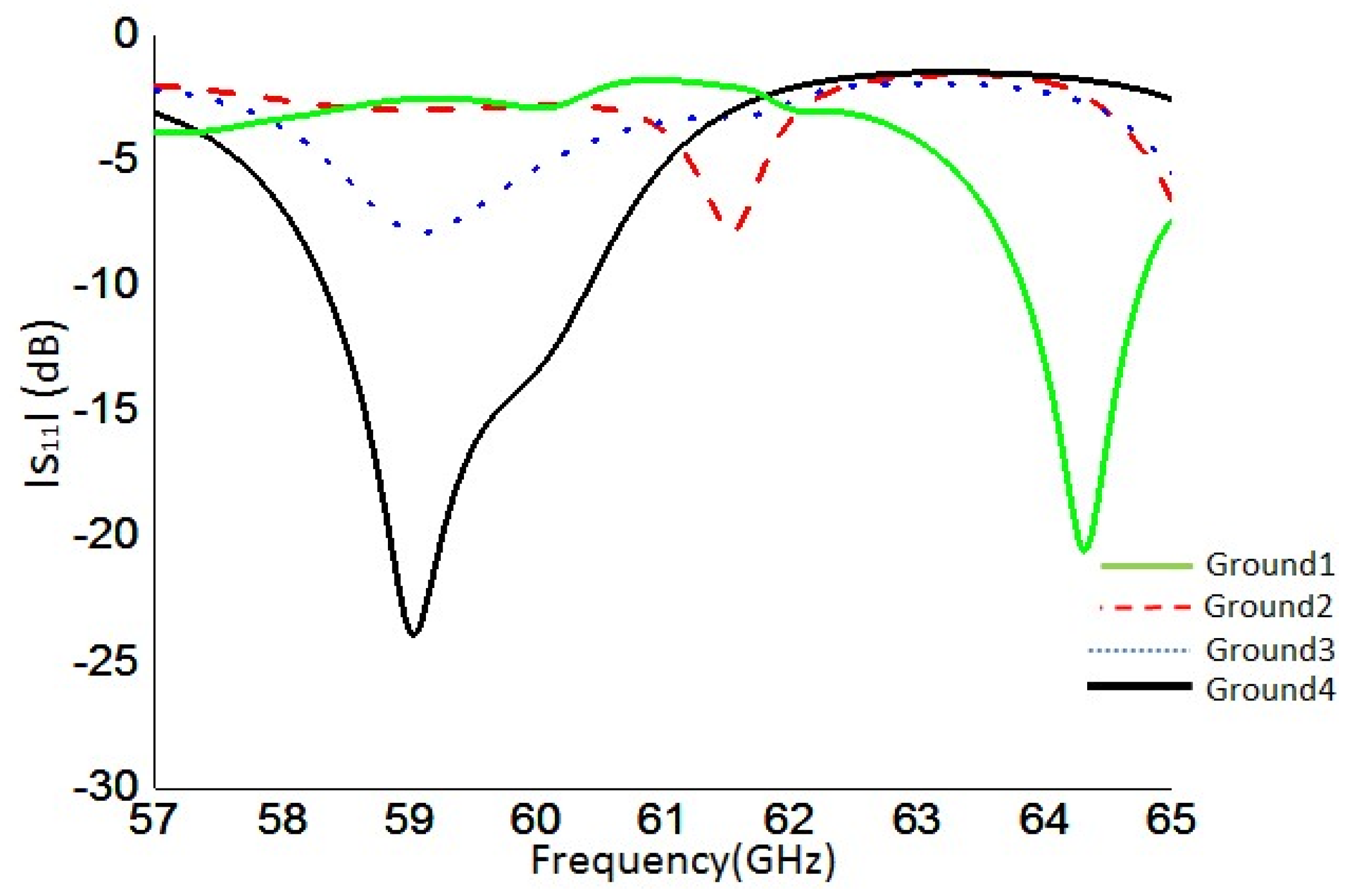
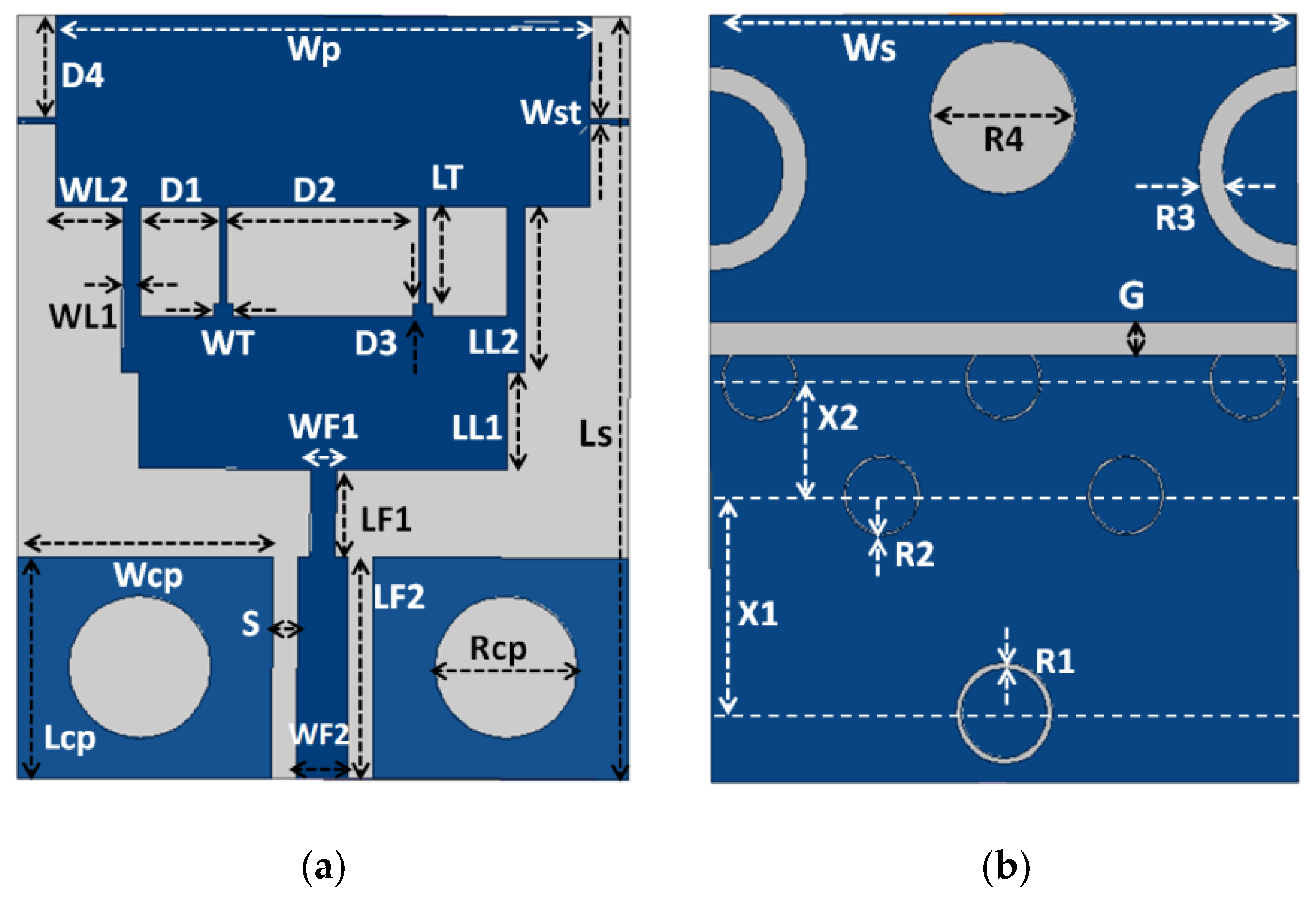

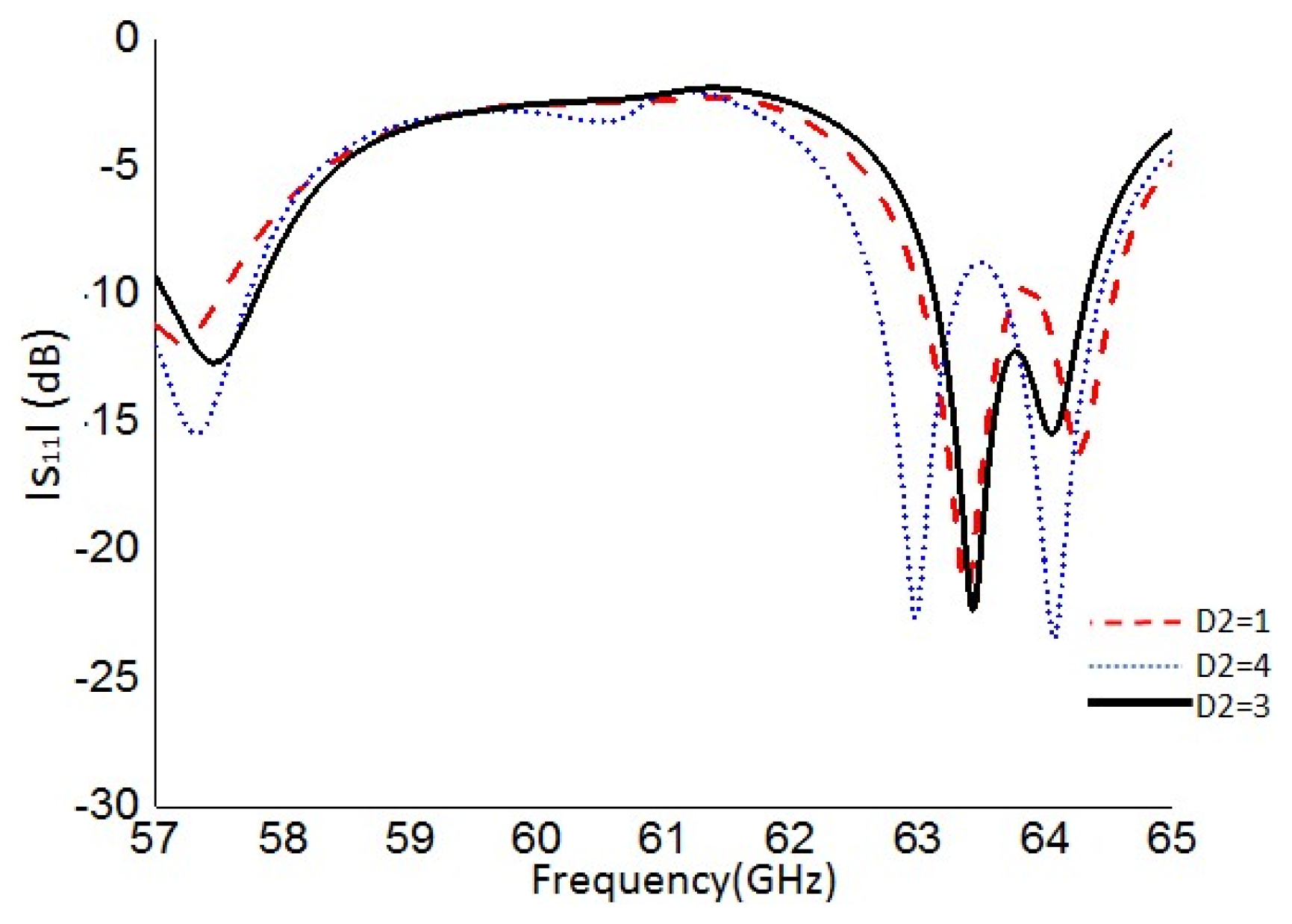
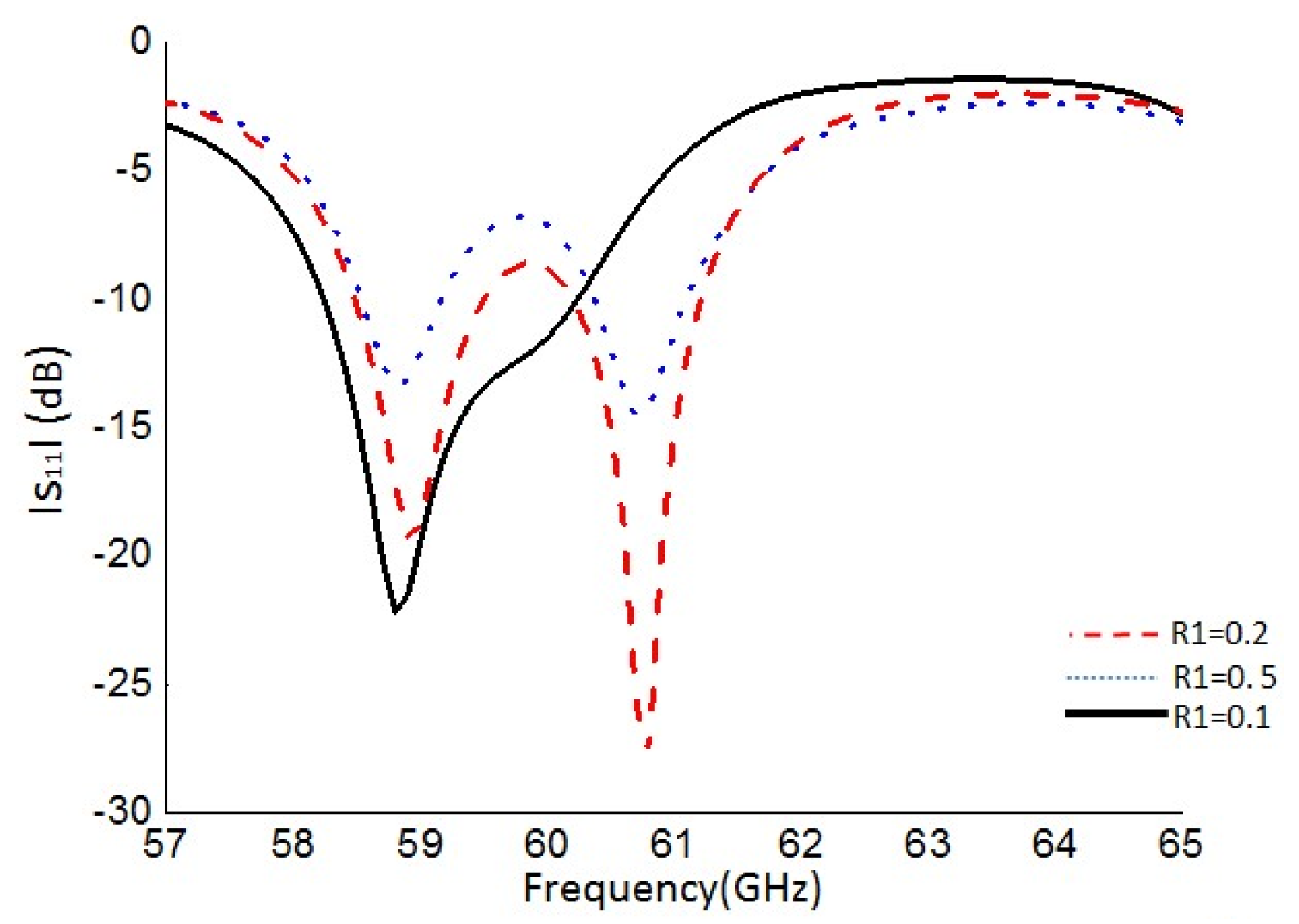
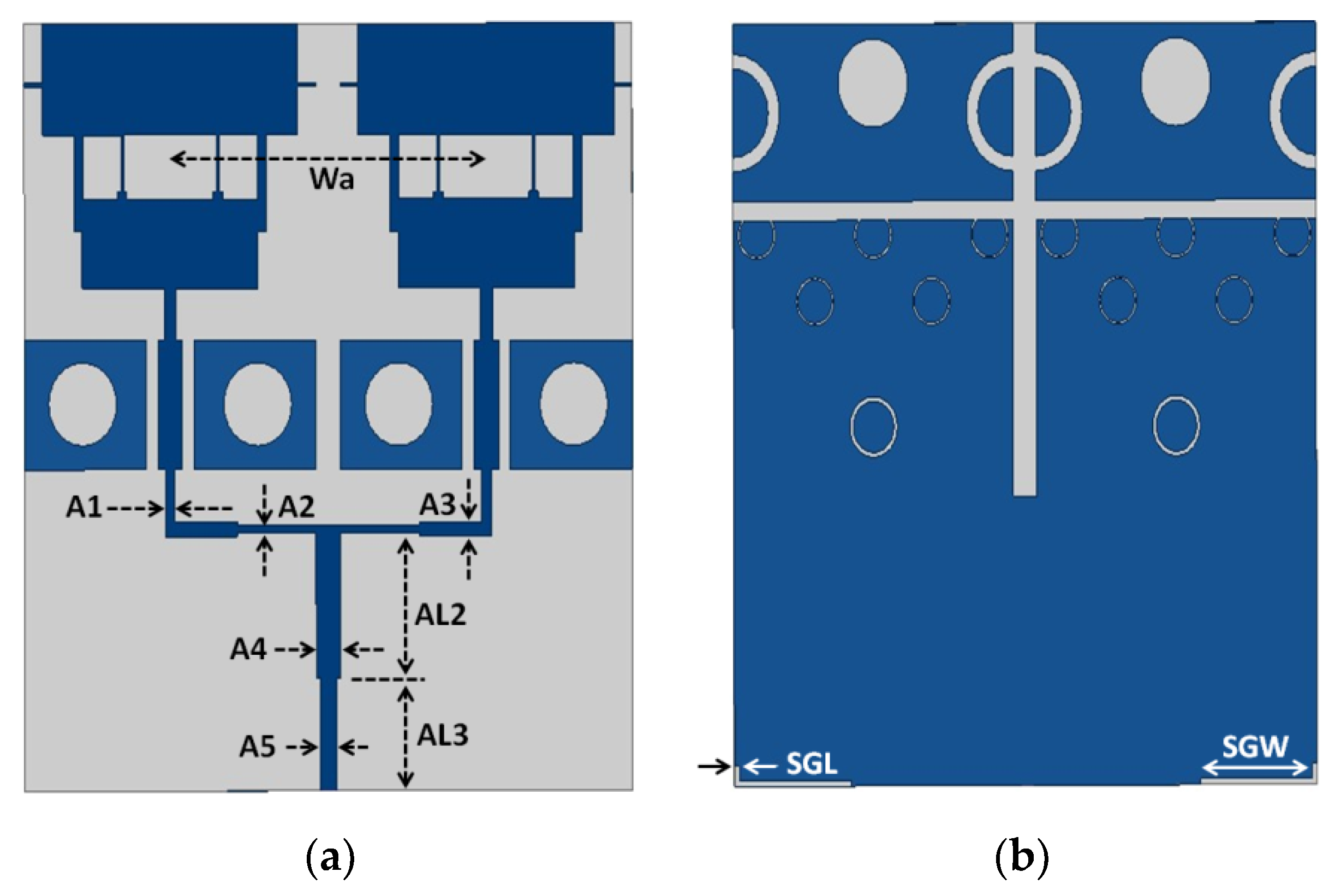
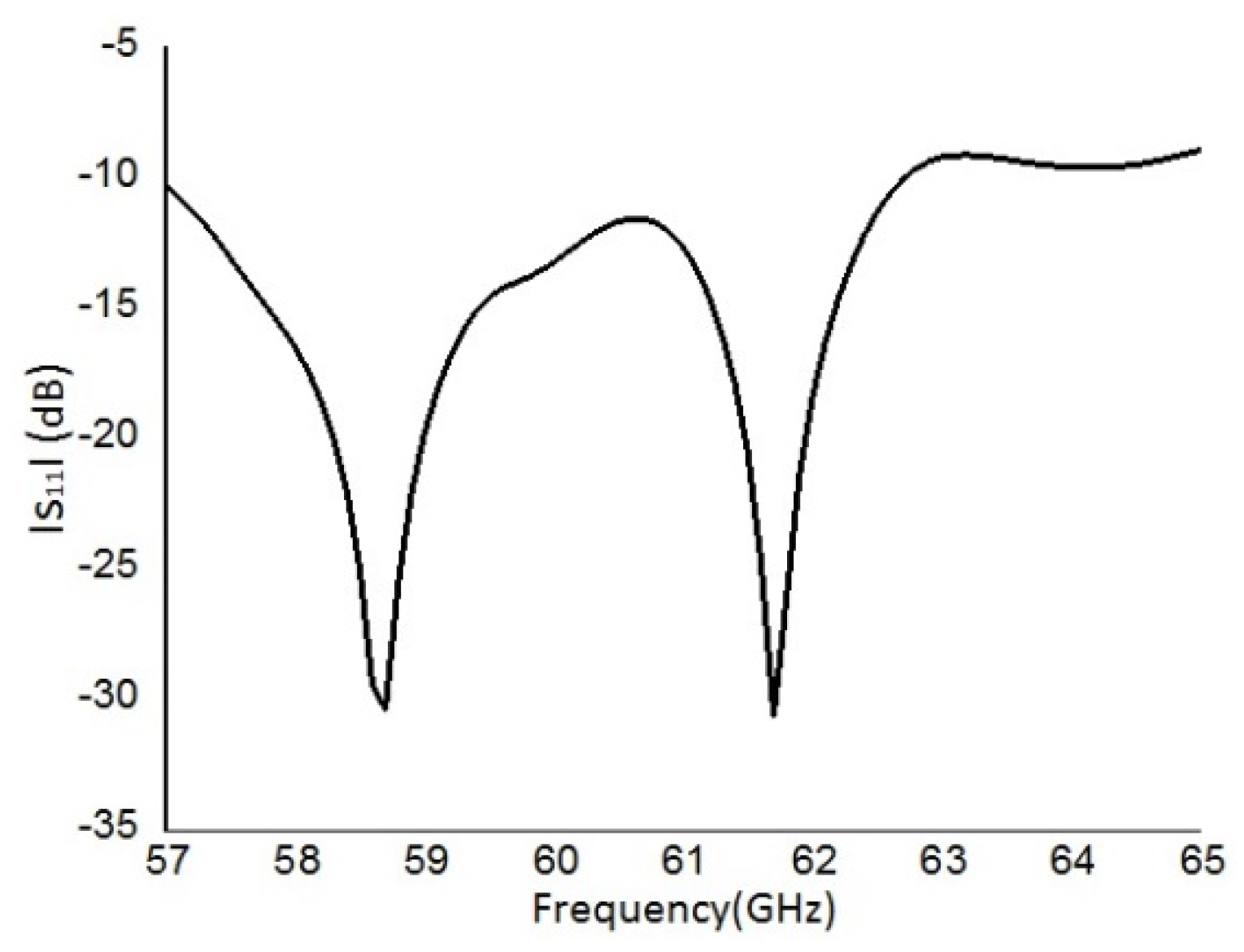



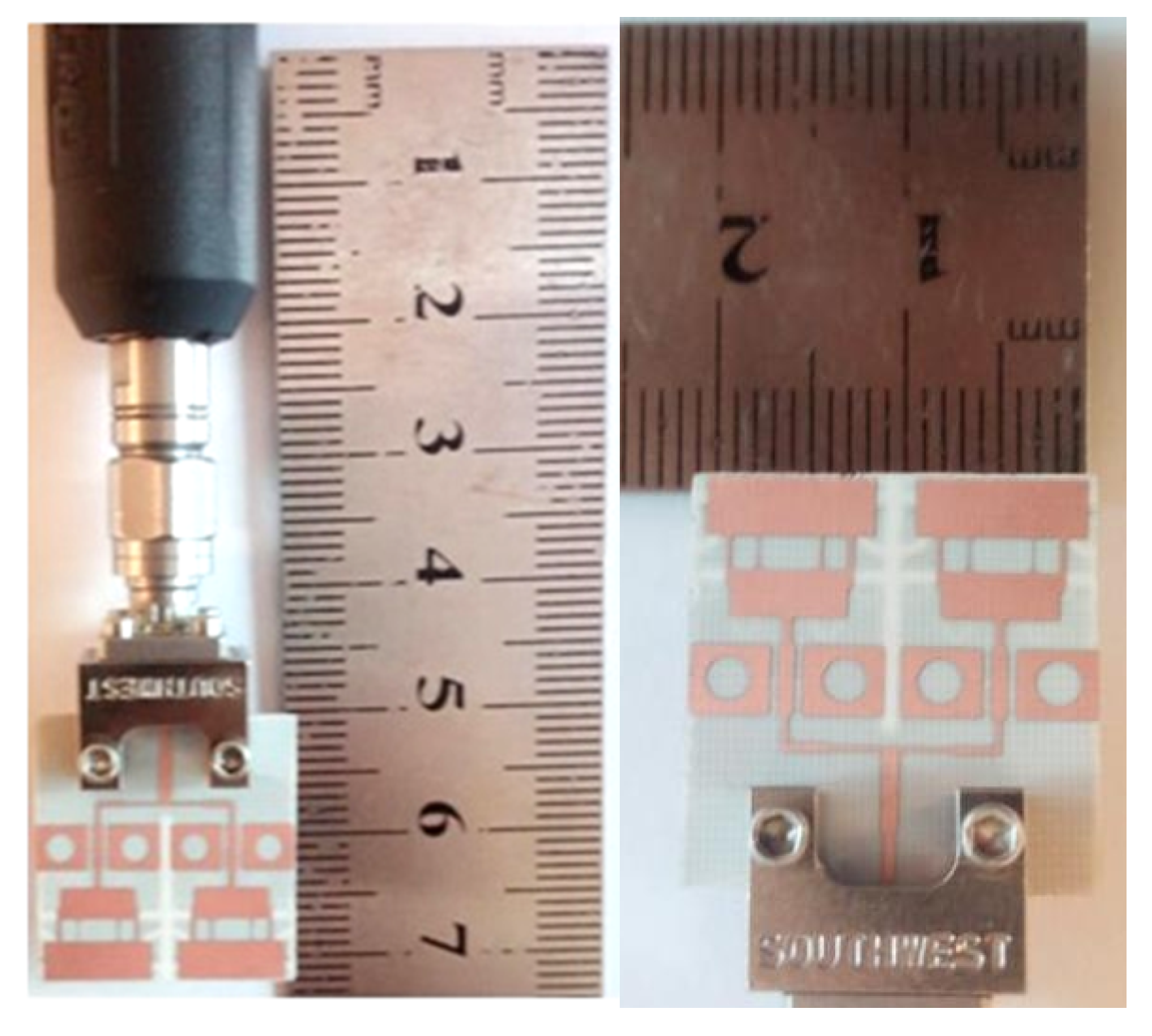
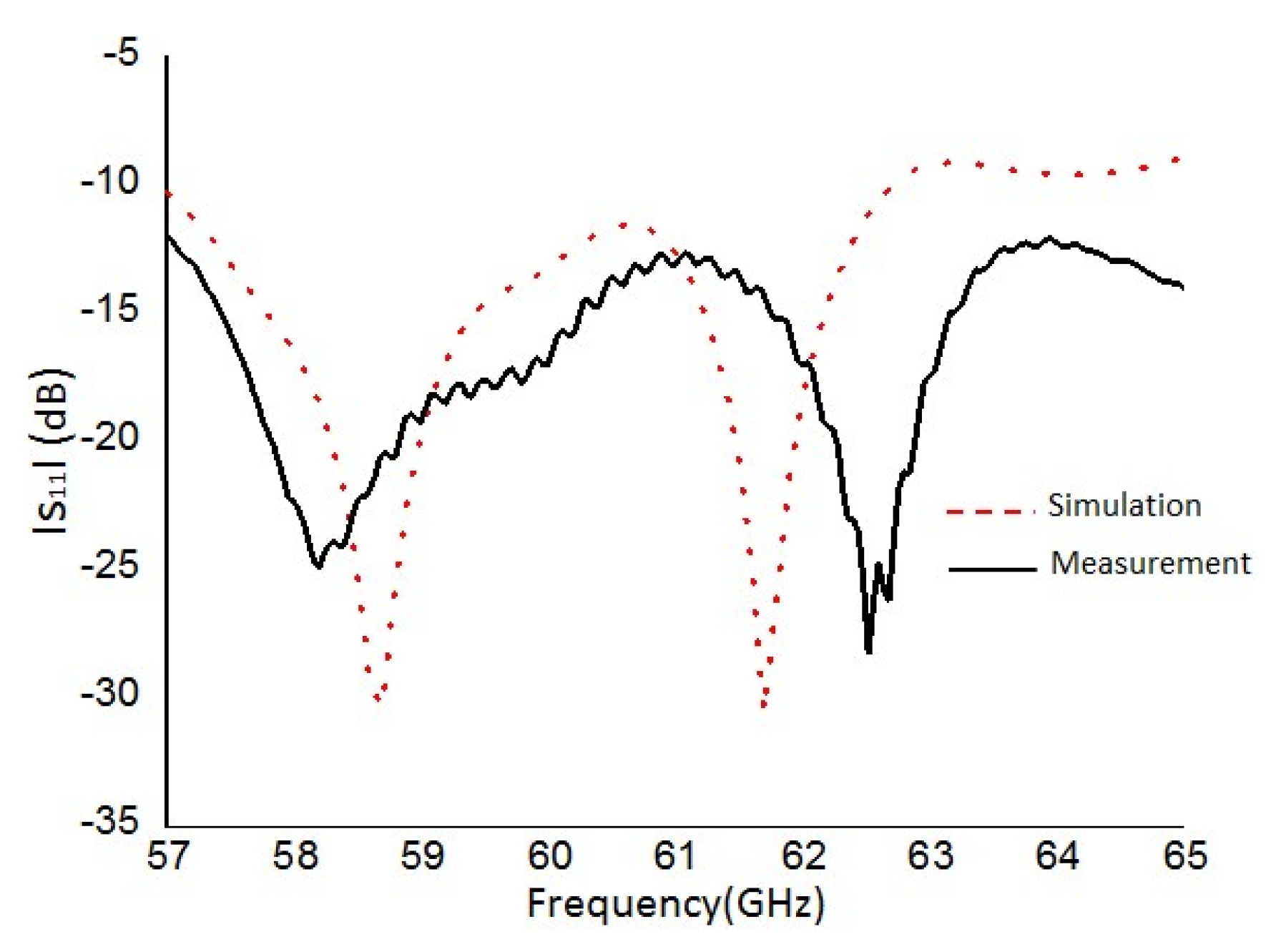
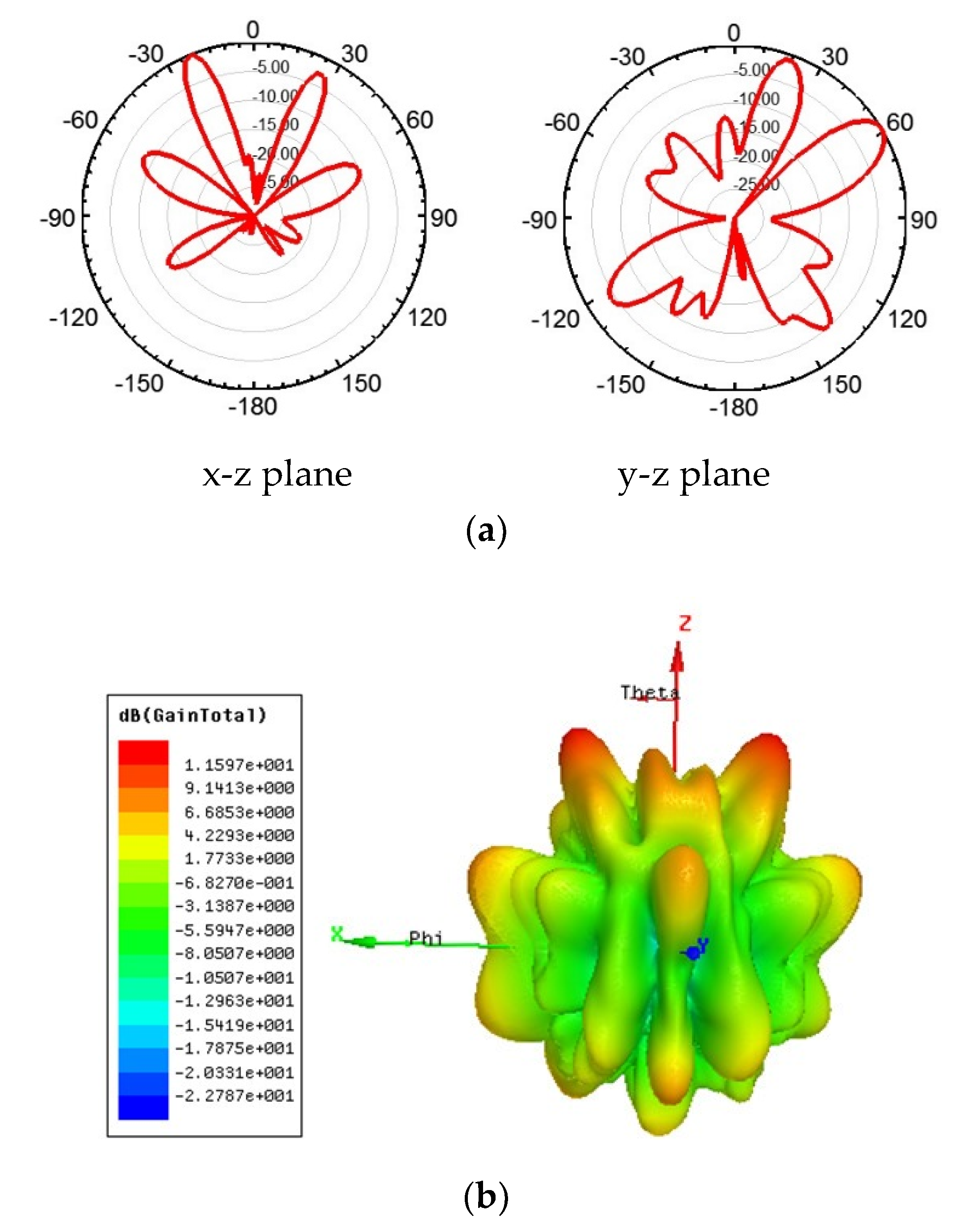
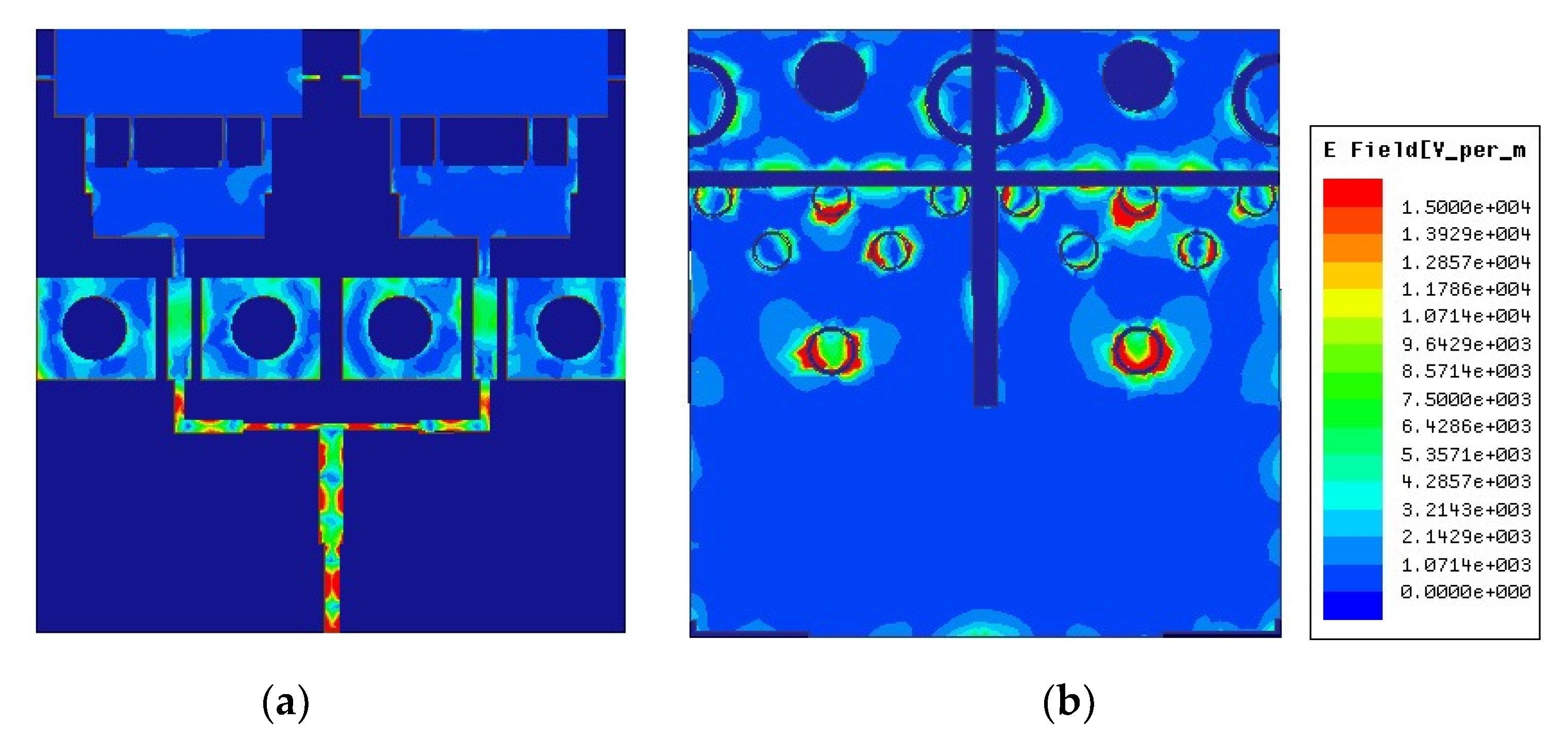
| Steps | Frequency (GHz) | Return Loss (dB) | Bandwidth (GHz) | Gain (dBi) |
|---|---|---|---|---|
| Iteration 1 | 59.5 | −22.9 | 1.15 | 6.87 |
| Iteration 2 | 63.51 | −13.7 | 1.45 | 8.1 |
| Iteration 3 | 63.27 | −24 | 1.43 | 9.3 |
| Iteration 4 | 63.35 | −22.5 | 1.275 | 8.14 |
| Iteration 5 | 64.25 | −21.3 | 1.5 | 8.4 |
| Steps | fc (GHz) | Return Loss (dB) | Bandwidth (GHz) | Gain (dBi) |
|---|---|---|---|---|
| Ground 1 | 64.25 | −21.3 | 1.5 | 8.4 |
| Ground 2 | 61.3 | −9 | - | 8.4 |
| Ground 3 | 59 | −8 | - | 8.3 |
| Ground 4 | 59 | −24.12 | 2.38 | 9.9 |
| Parameter | Value (mm) | Parameter | Value (mm) | Parameter | Value (mm) | Parameter | Value (mm) |
|---|---|---|---|---|---|---|---|
| Wp | 8.4 | D2 | 3 | Wcp | 4 | R2 | 0.04 |
| LL1 | 1.52 | D3 | 0.2 | Rcp | 1.12 | R3 | 0.4 |
| LL2 | 2.6 | D4 | 1.6 | S | 0.5 | R4 | 1.2 |
| WL1 | 0.27 | LF1 | 1.4 | Wst | 0.1 | X1 | 3.4 |
| WL2 | 1.04 | LF2 | 3.48 | Ls | 12 | X2 | 1.74 |
| LT | 1.52 | WF1 | 0.4 | Ws | 9.6 | - | - |
| WT | 0.3 | WF2 | 0.8 | G | 0.5 | - | - |
| D1 | 1.26 | Lcp | 3.48 | R1 | 0.1 | - | - |
| Parameter | Value (mm) | Parameter | Value (mm) |
|---|---|---|---|
| A1 | 0.3 | A5 | 0.5 |
| A2 | 0.2 | AL1 | 1.8 |
| A3 | 0.4 | AL2 | 3.9 |
| A4 | 0.8 | AL3 | 3.04 |
| SGL | 3.84 | SGW | 0.4 |
| Wa | 10.4 | - | - |
© 2020 by the authors. Licensee MDPI, Basel, Switzerland. This article is an open access article distributed under the terms and conditions of the Creative Commons Attribution (CC BY) license (http://creativecommons.org/licenses/by/4.0/).
Share and Cite
Mneesy, T.S.; Hamad, R.K.; Zaki, A.I.; Ali, W.A.E. A Novel High Gain Monopole Antenna Array for 60 GHz Millimeter-Wave Communications. Appl. Sci. 2020, 10, 4546. https://doi.org/10.3390/app10134546
Mneesy TS, Hamad RK, Zaki AI, Ali WAE. A Novel High Gain Monopole Antenna Array for 60 GHz Millimeter-Wave Communications. Applied Sciences. 2020; 10(13):4546. https://doi.org/10.3390/app10134546
Chicago/Turabian StyleMneesy, Tarek S., Radwa K. Hamad, Amira I. Zaki, and Wael A. E. Ali. 2020. "A Novel High Gain Monopole Antenna Array for 60 GHz Millimeter-Wave Communications" Applied Sciences 10, no. 13: 4546. https://doi.org/10.3390/app10134546
APA StyleMneesy, T. S., Hamad, R. K., Zaki, A. I., & Ali, W. A. E. (2020). A Novel High Gain Monopole Antenna Array for 60 GHz Millimeter-Wave Communications. Applied Sciences, 10(13), 4546. https://doi.org/10.3390/app10134546







